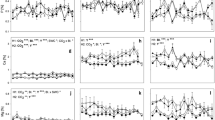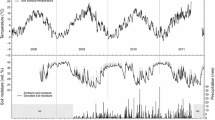Abstract
Seed production and seedling recruitment were measured over 2 years under ambient (360 ppm) and elevated (475 ppm) atmospheric CO2 in a free air carbon dioxide enrichment (FACE) experiment, carried out in a sheep-grazed pasture on dry, sandy soil in New Zealand. In both years elevated CO2 led to more dispersed seeds of the grasses Anthoxanthum odoratum, Lolium perenne and Poa pratensis, the legumes Trifolium repens and T. subterraneum and the herbs Hypochaeris radicata and Leontodon saxatilis. The increased seed dispersal in A. odoratum, H. radicata, Leontodon saxatilis and T. repens reflected both more inflorescences per unit area and more seeds per inflorescence under elevated CO2. The increased seed dispersal in Lolium perenne, P. pratensis and T. subterraneum was due solely to more inflorescences per unit area. The number of seedlings that emerged and survived to at least 7 months of age was increased by elevated CO2 for H. radicata, Leontodon saxatilis, T. repens and T. subterraneum in both years and for A. odoratum and Lolium perenne in the first year. For species where increased seedling recruitment was noted, there was a significant positive correlation between seed production in summer and seedling emergence in the following autumn and winter, and sowing 200 extra seeds per species m–2 resulted in more seedlings compared to unsown controls. Elevated CO2 did not affect seedling survival in any species. There was no measurable effect of elevated CO2 on canopy and soil surface conditions or soil moisture at the time of seedling emergence. The results suggest the dominant effect of elevated CO2 on seedling recruitment in this pasture was an indirect one, reflecting effects on the number of seeds produced. The biomass of H. radicata, Leontodon saxatilis, T. repens and T. subterraneum in the above-ground vegetation was greater under elevated than ambient CO2. However, the size of individual seedlings and mature plants of these four species was unaffected by elevated CO2. The results indicate an important way elevated CO2 influenced plant species composition in this pasture was through changes in the pattern of seedling recruitment.
Similar content being viewed by others

Author information
Authors and Affiliations
Additional information
Electronic Publication
Rights and permissions
About this article
Cite this article
Edwards, G., Clark, H. & Newton, P. The effects of elevated CO2 on seed production and seedling recruitment in a sheep-grazed pasture. Oecologia 127, 383–394 (2001). https://doi.org/10.1007/s004420000602
Received:
Accepted:
Published:
Issue Date:
DOI: https://doi.org/10.1007/s004420000602



